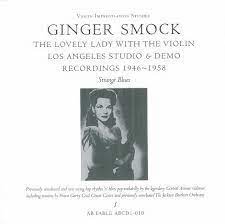
Daily Dose Of Jazz…
Ted Lewis was born Theodore Leopold Friedman on June 6, 1890 in Circleville, Ohio. His first instrument was the piccolo, however, he also learned to play the C-melody saxophone but was known principally as a clarinetist throughout his long career.
He was one of the first Northern musicians to imitate the style of New Orleans jazz musicians who came to New York in the 1910s. He first recorded in 1917 with Earl Fuller’s Jazz Band, a band attempting to copy the sound of the Original Dixieland Jass Band.
His earliest clarinet recordings were not very good but as his career gained momentum he refined his style under the influence of the first New Orleans clarinetists Larry Shields, Alcide Nunez, and Achille Baquet who relocated to New York.
By 1919, Lewis was leading his own band, and had a recording contract with Columbia Records. At the start of the Roaring Twenties, he was being promoted as one of the leading lights of the mainstream form of jazz popular at the time. He hired musicians Benny Goodman, Jimmy Dorsey, Frank Teschemacher, and Don Murray to play clarinet in his band. Over the years he hired trumpeter Muggsy Spanier and trombonist George Brunies as he led his band to be second only to the Paul Whiteman band in popularity.
One of his most memorable songs, Me and My Shadow, had usher Eddie Chester mimicking his movements during his act. He then hired four Black shadows, the most famous being Charles “Snowball” Whittier, making Lewis one of the first prominent white entertainers to showcase Black performers, albeit in stereotypical ways, to be onstage, on film, and eventually on network television.
Remaining successful through the Great Depression, Ted adopted a battered top hat for sentimental, hard-luck tunes. He kept his band together through the 1950s and continued to make appearances in Las Vegas, Nevada and on the popular television shows of the decade. He would go on to perform in the early talkie films by Universal Studios and Columbia Pictures.
Clarinetist, bandleader, and singer Ted Lewis, transitioned in his sleep from lung failure on August 25, 1971 in New York City. He was 81. His memorabilia resides in The Ted Lewis Museum, created by his wife Adah, located across the street from where he was born in Circleville.
More Posts: bandleader,clarinet,history,instrumental,jazz,music,vocal

Daily Dose Of Jazz…
Mick Hutton was born on June 5, 1956 in Chester, United Kingdom. Making a name for himself in the British jazz scene, he worked with a number of musicians and groups including but not limited to Harry Beckett, Julian Argüelles, Iain Ballamy, Django Bates and Ken Stubbs of First House, the Chris Biscoe Sextet and Bill Bruford’s Band Earthworks.
A hand injury forced Mick to abandon the upright bass and he started working as bass guitarist, percussionist, and synthesizer player and as a composer. He works with his own band of saxophonist Andy Panayi, pianist Barry Green, and drummer Paul Robinson. With his quartet, including saxophonist Iain Ballamy, pianist Ross Stanley and drummer Paul Robinson, he frequently visits venues around the world.
Throughout his career Hutton has performed with Alan Barnes, Peter Erskine, Tina May, Jim Mullen, John Scofield, Alan Skidmore, Tommy Smith, John Taylor, Stan Tracey, and Kenny Wheeler. In 2002 he recorded on Robin Williamsons album Skirting the River Road, and the same year he played in a trio with Martin Speake and Paul Motian, recording Change of Heart.
Bassist, guitarist, percussionist and composer Mick Hutton, who also plays synthesizer, continues to perform and record.
More Posts: bass,composer,guitar,history,instrumental,jazz,music,percussion,synthesizer

Requisites
My Conception ~ Sonny Clark | By Eddie Carter
Sonny Clark enters this morning’s spotlight with a 1959 recording session that remained in the vault for two decades. My Conception (Blue Note GXF 3056) is a 1979 release that came out first in Japan and later as a 2000 CD album in the US. Clark was one of the label’s house pianists, recording some of his finest albums as a leader. He also appeared on numerous releases as a sideman. Here, Sonny is leading a stellar quintet in a program of his original tunes. Donald Byrd on trumpet, Hank Mobley on tenor sax, Paul Chambers on bass, and Art Blakey on drums. My copy is the 2021 Blue Note Tone Poet Series Stereo audiophile reissue (BST 22674).
Junka starts with the quintet’s upbeat melody. In the opening reading, Hank gets things going energetically, then Donald makes an impressive appearance. Sonny follows with a high-spirited statement next. Paul delivers a sparkling comment; then Art shares the last spot with the front line preceding the theme’s reprise. Blues Blue starts with the quintet’s danceable beat in the opening chorus. Mobley leads the way with an attractive reading, then Byrd comfortably swings into the next segment. Clark improvises the following message effectively, then Chambers’ inspired bass work comes. Blakey shares the final conversation with both horns ahead of the climax.
There’s nothing minor about the first side finale, Minor Meeting. Art calls the quintet together for their vivacious melody. Donald is off and running in the opening solo, then Hank soars to new heights in the following presentation. Sonny closes with a series of scintillating choruses leading to the finale. Side Two commences with Royal Flush, a toe-tapping medium groove that gets underway with the ensemble’s theme. Mobley goes to work first, followed by Clark’s thoroughly relaxed reading. Byrd is up next and is shown to good advantage, and Chambers takes the final stroll while Blakey keeps the beat into the quintet’s closing chorus.
The group enjoys Some Clark Bars next. After the group establishes the spirited melody, Hank leads the way in a terrific opening solo as tasty as the candy bar. Donald swings as hard in the following interpretation, and Sonny has a great turn in the third reading. Art finishes off the solos in a concise exchange, with the front line before the close. The title tune, My Conception, is a perfect example of Clark’s ability to compose a beautiful ballad. The rhythm section opens with a tender introduction until Mobley emerges to give an elegantly phrased theme and lead solo. Clark takes over to give a wonderfully warm statement, then Byrd concludes with a delicately expressed performance of soulful emotion.
Alfred Lion produced the initial session, and Rudy Van Gelder was the man behind the dials of the recording. Joe Harley supervised the audiophile reissue, and Kevin Gray remastered the album. The front and rear covers are high gloss, with great session photos inside the gatefold. The sound quality is sensational, with an exceptional soundstage. The instruments emerge from your speakers as if you’re in the studio with the musicians while they work. The record was pressed on 180-gram audiophile vinyl, and it’s incredibly quiet until the music starts. If you’re in the mood for Hard-Bop, I invite you to check out My Conception by Sonny Clark the next time you’re out vinyl shopping. Despite being unreleased for so many years, it’s a great album that was well worth the wait and a joy to listen to!
~ My Conception (Blue Note Connoisseur Series 7243 5 22674 2 2) – Source: Discogs.com © 2023 by Edward Thomas Carter
More Posts: choice,classic,collectible,collector,history,instrumental,jazz,music,piano

Daily Dose Of Jazz…
Ginger Smock was born Emma Smock on June 4, 1920 in Chicago, Illinois and grew up in Los Angeles, California. She graduated from Jefferson High School and studied violin privately with Bessie Dones. By the time she hit the age of 10 she appeared as a soloist at the Hollywood Bowl. She was featured on Clarence Muse’s radio program at the age of thirteen performing Edward MacDowell’s To A Wild Rose. She earned degrees in music from Los Angeles City College, and the Zoellner Conservatory of Music. At the latter institution she was a pupil of Edith Smith.
During 1944 she led a trio with Nina Russell and Mata Roy. In 1951, she led an all-female sextette, featuring Clora Bryant, on the Chicks and the Fiddle show hosted by Phil Moore that broadcasted for six weeks on CBS. The next year she was the featured soloist on KTLA’s variety show, Dixie Showboat.
1953 had Smock recording as part of a group with Gerald Wiggins, Freddie Simon, Red Callender, and Rudy Pitts, accompanying the vocalist Cecil “Count” Carter.
During the mid 1970s, she spent ten years as concertmaster of show orchestras in Las Vegas. In addition to her work in jazz and rhythm & blues, she performed with the All City Symphony Orchestra of Los Angeles. A violin owned by Smock is in the collection of the National Museum of African American History and Culture
Violinist, orchestra leader, and local Los Angeles television personality Ginger Smock, who recorded as a leader but is perhaps best known from her recordings with the Vivien Garry Quintet, transitioned on June 13, 1995.
More Posts: bandleader,concertmaster,history,instrumental,jazz,music,violin

Daily Dose Of Jazz…
Robert Wallis was born on June 3, 1934 in Bridlington, East Riding of Yorkshire, where his father became harbour master. At an early age he joined the local Salvation Army band with his friend, Keith Avison, who was to play trombone with Wallis for a number of years. By the age of twenty, he discovered jazz and set up his own band in his seaside town,which also played in Hull, England.
He went to Denmark for a short spell, and recorded a couple of records there as the vocalist with the Washboard Beaters. Relocating to the UK, Bob went to London and played for a short time with Ken Colyer’s Omega Brass, as well as joining Acker Bilk. These bands were recording mainly for the specialist 77 Records label.
He joined up with Hugh Rainey’s All Stars whereGinger Baker was their drummer at the time. Shortly afterwards the band changed its name to The Storyville Jazz Band, fronted by Wallis. In 1959 the band recorded an album for Top Rank Records, Everybody Loves Saturday Night. The band recorded several singles before moving to Pye Records where they recorded three more albums and released a few singles.
1963 saw Wallis and his band disbanded and he played with one or two other bands before moving to the Continent where he spent most of his remaining years, still playing with reconstituted versions of the Storyville Jazzmen. That same year he participated in the biggest trad jazz event staged in Britain at Alexandra Palace which included George Melly, Diz Disley, Acker Bilk, Chris Barber, Kenny Ball, Ken Colyer, Monty Sunshine, Alex Welsh, Bruce Turner and Mick Mulligan.
Ultimately he settled in Zurich, Switzerland with a residency at the Casa Bar. He continued to make records for European record labels Storyville Records, WAM and Pebe. Trumpeter Bob Wallis, whose influence was Henry Red Allen, returned to England with his wife, Joyce, where he transitioned in hospital on January 10, 1991 at the age of 56.
More Posts: bandleader,history,instrumental,jazz,music,trumpet


